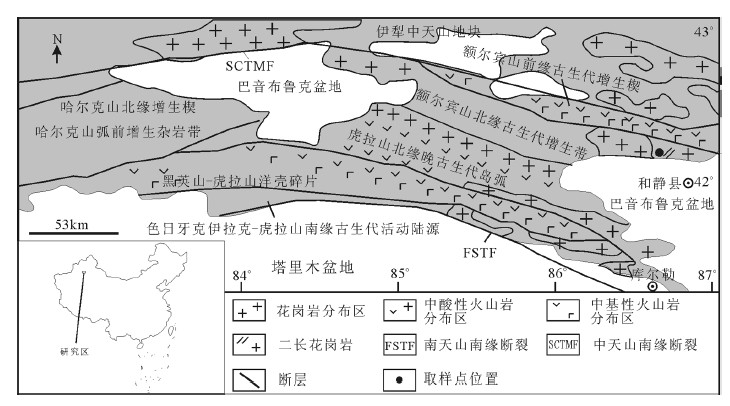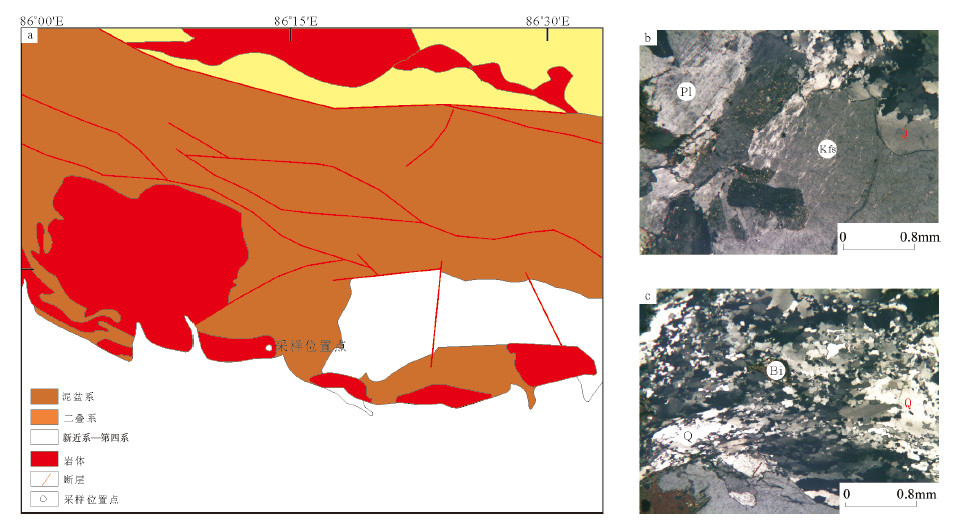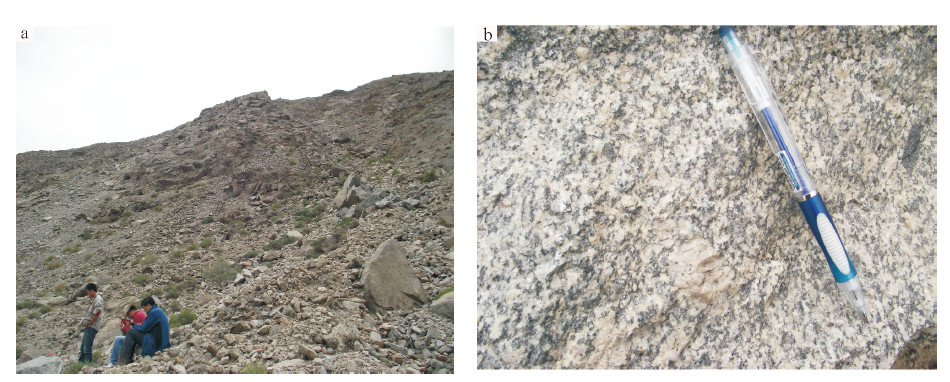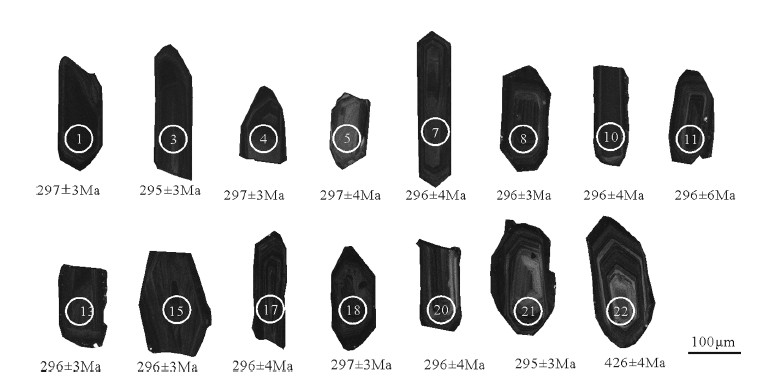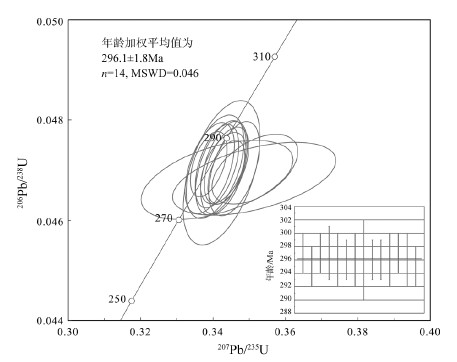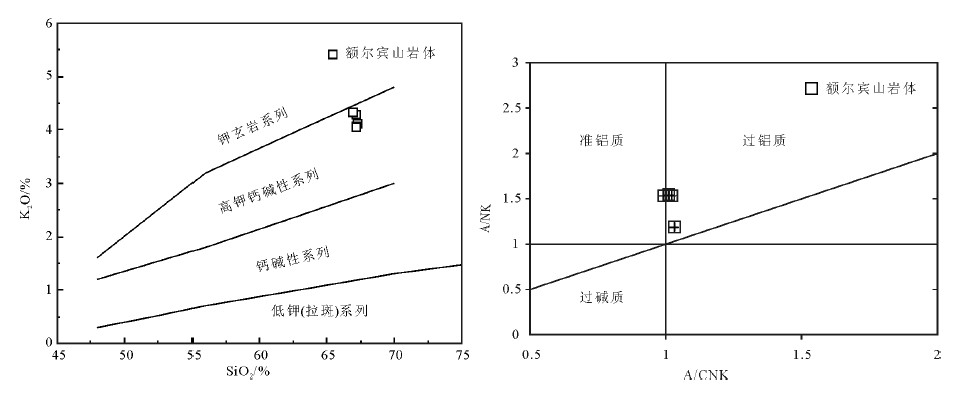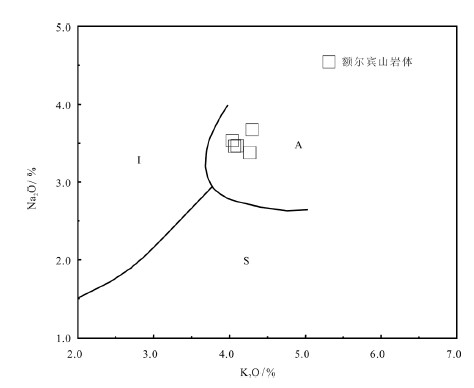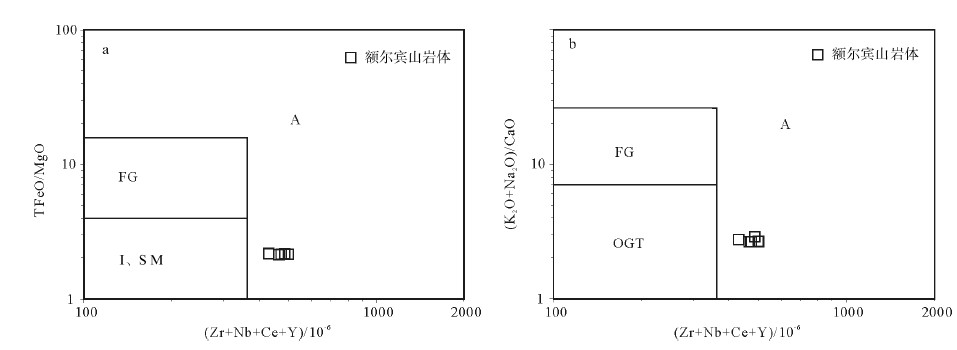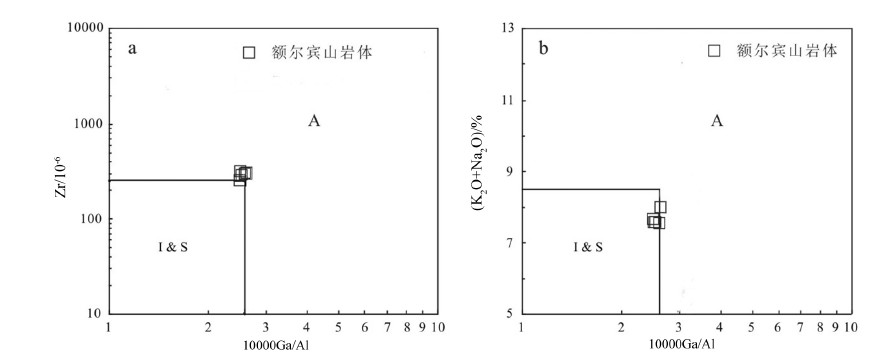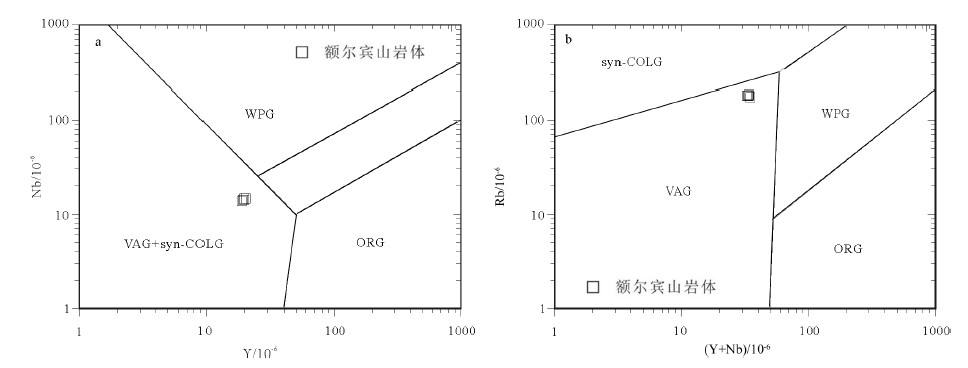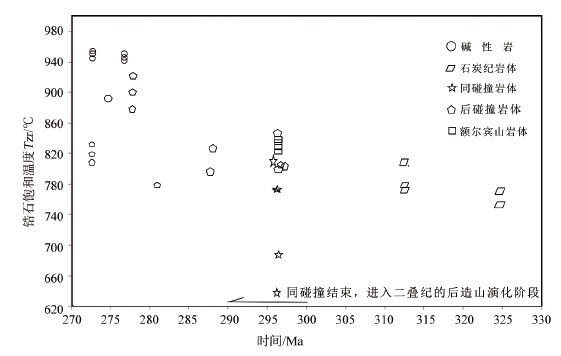Ages and geochemistry of the Erbeng granite in southern Tianshan orogenic belt, Xinjiang: New constraints on the tectonic evolution of the southern Tianshan Ocean
-
摘要:
额尔宾山花岗岩岩体位于南天山晚古生代侵入岩带, 对该花岗岩进行锆石U-Pb定年获得296.1±1.8Ma的年龄, 为早二叠世。岩石主量元素分析结果表明, 该花岗岩的SiO2含量为66.96%~67.3%, 富碱(Na2O+K2O=7.53%~7.97%), K2O/Na2O>1(1.15~1.27), 属高钾钙碱性系列岩石; Al2O3为15.56%~15.62%, Al2O3>K2O+Na2O+CaO, 属于过铝型。岩石稀土元素配分模式呈现轻稀土元素(LREE)富集((La/Yb)N=27.03~30.62)、重稀土元素(HREE)亏损((LREE/HREE)=18.2~20.1)、具有中等程度的负Eu异常(δEu=0.64~0.68)。微量元素判别结果显示, 其具有I-A型花岗岩过渡的特征。结合区域地质背景综合分析, 初步认定该岩体可能形成于南天山同碰撞向后碰撞构造体制转换时期, 据此可以推测南天山洋盆闭合时限至少应该在早二叠世以前。
Abstract:Erbeng plutons are located along the South Tianshan Late Paleozoic intrusive rock belts. LA-ICP-MS dating yielded a zir-con U-Pb age of 296.1±1.8Ma(MSWD=0.05), suggesting that this body was emplaced in the Early Permian. The granites from the Erbeng plutons are characterized by silica(66.96%~67.3%) and rich alkali(Na2O+K2O=7.53%~7.97%), obvious variation of K2O/Na2O(1.15~1.27) with the A/CNK being 0.99~1.03, suggesting that they are of weakly peraluminous and high-K calc-alkaline series. They are enriched in LREE((La/Yb)N=27.03~30.62) and depleted in HREE((LREE/HREE)=18.2~20.1). They have negative Eu anomaly(δEu=0.64~0.68), with slightly right-dipping V-type chondrite-normalized rare earth element patterns. Geochemical-ly, they show transition features from I to A type granites. This age, together with their geochemical signatures of I-A type granite and the zircon saturation temperatures of 819~837℃, indicates that this body was emplaced at a transition stage from syncollision to post-collision. From the zircon U-Pb ages combined with regional geological background, the authors infer that the southern Tian-shan Ocean might have been closed at least before the beginning of the Early Permian.
-
Keywords:
- Erbeng plutons /
- zircon U-Pb dating /
- South Tianshan Ocean /
- closure time
-
长期以来,华南早古生代的大地构造背景一直存在争议。有的学者认为存在“华南洋”,倡导用“洋-陆碰撞”的模式来解释[1-3]。然而,越来越多的证据表明,发生于华南早古生代的“广西运动”更可能是板内造山运动[4-14],是世界上为数不多的板内造山运动的实例之一[15]。近年来,对该板内造山运动(广西运动)的构造属性和动力机制研究已经取得了重大进展[4-8, 15],但广西运动在不同地区的表现形式仍未得到有效制约。
华南早古生代花岗岩分布广泛且数目较多(约100个),岩体规模悬殊,总面积约2.2×104km2[16]。其中,强过铝质的花岗质侵入体约占总数的58.7%(A/ CNK>1.10)[17],属于S型花岗岩,可能源自于加厚地壳状态下含水矿物的脱水熔融或加厚地壳垮塌产生的等温减压引发的部分熔融[7]。其中,约460Ma的过铝质花岗岩主要集中于武夷—云开、赣南—粤北等地区[4-6],对于限定板内造山运动的性质具有重要的指示意义,而南岭西段地区远离造山核部,鲜有相关报道。最近,笔者通过对桂北灵川县新寨花岗岩的LA-ICP-MS锆石U-Pb年龄研究发现,该岩体形成于465±2Ma,地球化学特征上属于强过铝质的S型花岗岩,本文重点报道该成果。同时,在岩体地质、元素地球化学和Sr-Nd-Hf同位素研究的基础上,结合华南其他地区早古生代花岗岩的研究资料,讨论其岩石成因和动力学意义。
1. 岩体地质特征
新寨花岗质侵入体位于湘中—桂中南北西向构造带和海洋山复式向斜的西南端,区域上受控于近南北向的大镜-沙子断裂(图 1-a)。侵入体侵入寒武系—奥陶系,为泥盆系沉积覆盖。大地构造位置上,侵入体位于扬子地块和华夏地块的结合部位,安化-罗城断裂和郴州-临武断裂之间(图 1-b)。相对于郴州-临武断裂以东地区,研究区及其附近早古生代花岗岩分布较少。侵入体出露面积16.7km2,侵入于老厂穹隆的轴部。广西壮族自治区地质局①据侵入关系将新寨花岗质侵入体年代定为加里东期,张相训等[18]获得其锆石207Pb/206Pb年龄为493±21Ma,归于早奥陶世。
新寨侵入体主要岩性为中细粒斑状角闪黑云二长花岗岩,少量中细粒花岗闪长岩和黑云母花岗岩。岩石普遍遭受蚀变,岩体内部发育暗色包体,多为闪长质和花岗闪长质。岩石主要造岩矿物为斜长石(35%)、钾长石(40%)、石英(20%)和少量黑云母、角闪石( < 5%)。其中斜长石呈半自形板状,绢云母化,黝帘石化,局部可见被钾长石交代的蚕蚀状、净边结构;钾长石为条纹长石,半自形板状-他形粒状,高岭土化;黑云母和角闪石多绿泥石化。副矿物组合为磁铁矿、锆石、磷灰石和电气石。
2. 分析方法
本次采集的锆石U-Pb同位素年龄测试样品为N38-1,样品坐标为北纬25°08′14.9″、东经110°34′ 55.2″。锆石样品挑选过程中,先将新鲜的岩石样品粉碎至120目以下,用常规的人工淘洗和电磁选方法富集锆石,再在双目镜下手工逐个精选锆石颗粒。本次锆石定年样品与主量和微量元素分析的样品相对应。锆石阴极发光(CL)图像拍摄在中国地质大学JXA-8100电子探针仪上完成。LA-ICPMS锆石U-Pb年龄测定在西北大学大陆动力学国家重点实验室的Agilent7500型ICPMS和德国Lambda Physik公司的Compex102ArF准分子激光器(工作物质ArF,波长193nm)及MicroLas公司的GeoLas200M光学系统的联机上进行。激光束斑直径为44μm,剥蚀深度为20~40μm。实验中采用氦气作为剥蚀物质的载气,用美国国家标准技术研究院研制的人工合成硅酸盐玻璃标准参考物质NIST610进行最佳化,使仪器达到最高的灵敏度、最小的氧化物产率、最低的背景值和稳定的信号,采样方式为单点剥蚀,数据采集选用一个质量峰一点的跳峰方式(peak jumping)。锆石U-Pb年龄测定采用标准锆石91500作为外标标准物,外标校正方法为每隔6个样品分析点测1次标样,保证标准和样品的仪器条件尽可能一致。元素含量采用NIST SRM610作为外标,29Si作为内标。锆石U-Pb年龄测试仪器的运行条件、详细的分析流程参见袁洪林等[19]。样品的同位素比值采用软件ICPMSDataCal完成[20],相关结果按照Anderson的方法处理[21],年龄计算及谐和图的绘制采用Isoplot(ver2.49)[22]完成。分析数据列于表 1。在进行锆石U-Pb年龄测定的同时,在LA-MC-ICP-MS上获得锆石原位Hf同位素组成。测定时采用标样91500和GJ-1、MON-1作为外标。在ε Hf(t)值计算中,采用Blichert等[23]推荐的球粒陨石值。亏损地幔模式年龄(TMD)计算采用Griffin等[24]的推荐值。分析数据列于表 2。
表 1 新寨花岗岩LA-ICP-MS锆石U-Th-Pb同位素分析数据Table 1. LA-ICP-MS U-Th-Pb isotopic data for zircons of the Xinzhai granites点号 Pb Th U 比值(经普通铅校正) 年龄(经普通铅校正)/Ma /10-6 207Pb/206Pb ±1σ 207Pb/235U ±1σ 206Pb/238U ±1σ 207Pb/206Pb ±1σ 207Pb/235U ±1σ 206Pb/238U ±1σ 1 340 1852 3872 0.05193 0.00073 0.5387 0.0073 0.07484 0.00055 282 27 438 5 465 3 2 314 1485 3695 0.04815 0.00062 0.5014 0.0067 0.07502 0.0005 107 28 413 5 466 3 3 279 1304 3243 0.05273 0.00101 0.5520 0.0138 0.07484 0.00067 317 54 446 9 465 4 4 218 983 2585 0.04956 0.00074 0.5187 0.0074 0.07546 0.00035 174 32 424 5 469 2 5 180 696 2182 0.04983 0.00081 0.5184 0.0084 0.07500 0.00038 187 37 424 6 466 2 6 251 1809 2752 0.05398 0.00097 0.5621 0.0099 0.07515 0.00054 370 37 453 6 467 3 7 367 1511 4445 0.05268 0.00074 0.5448 0.0077 0.07464 0.00051 315 29 442 5 464 3 8 307 1709 3336 0.05406 0.00077 0.5684 0.0087 0.07580 0.00054 373 31 457 6 471 3 9 506 3225 6517 0.05389 0.00064 0.5140 0.0064 0.06884 0.00052 366 23 421 4 429 3 10 254 1070 3089 0.05584 0.00083 0.5800 0.0078 0.07506 0.00057 446 25 464 5 467 3 11 431 2850 4939 0.05645 0.00074 0.5833 0.0073 0.07472 0.00062 470 21 467 5 465 4 12 335 1456 3850 0.05733 0.00095 0.6010 0.0099 0.07574 0.00065 504 32 478 6 471 4 13 448 2762 5309 0.05446 0.00078 0.5646 0.0081 0.07499 0.00067 390 26 455 5 466 4 14 397 3076 4596 0.05262 0.00066 0.5448 0.0068 0.07472 0.00035 313 27 442 4 465 2 15 436 3203 5232 0.05188 0.00063 0.5262 0.0064 0.07320 0.00037 280 26 429 4 455 2 16 317 2249 3757 0.05144 0.00064 0.5232 0.0068 0.07346 0.00051 261 26 427 5 457 3 17 438 2426 5146 0.05038 0.00057 0.5234 0.0062 0.07501 0.00045 213 24 427 4 466 3 18 268 1250 3182 0.05094 0.00066 0.5272 0.0077 0.07470 0.00055 238 30 430 5 464 3 表 2 新寨花岗岩锆石Lu-Hf同位素分析结果Table 2. Lu-Hf isotopic analyses for zircons of the Xinzhai granites点号 176Yb/177Hf 176Lu/177Hf 176Hf/177Hf 2σ T/Ma ε Hf(t) 2σ THf1/Ga THf2/Ga 01 0.025163 0.000830 0.282463 0.000011 465 -0.95 0.4 1.11 1.78 02 0.027225 0.000853 0.282346 0.000013 466 -5.06 0.5 1.27 2.04 03 0.029851 0.000952 0.282370 0.000012 465 -4.27 0.4 1.24 1.99 04 0.040693 0.001246 0.282317 0.000014 469 -6.18 0.5 1.33 2.11 05 0.029434 0.000908 0.282359 0.000009 466 -4.63 0.3 1.26 2.02 06 0.054760 0.001624 0.282430 0.000014 467 -2.32 0.5 1.18 1.86 07 0.030690 0.000943 0.282388 0.000009 464 -3.66 0.3 1.22 1.95 08 0.036582 0.001166 0.282469 0.000011 471 -0.73 0.4 1.11 1.77 09 0.051495 0.001635 0.282528 0.000019 429 0.35 0.7 1.04 1.64 10 0.047695 0.001418 0.282391 0.000012 467 -3.64 0.4 1.23 1.94 11 0.044739 0.001420 0.282480 0.000014 465 -0.51 0.5 1.10 1.74 12 0.032905 0.001018 0.282385 0.000014 471 -3.65 0.5 1.23 1.96 13 0.042287 0.001289 0.282477 0.000013 466 -0.55 0.5 1.10 1.75 14 0.051338 0.001555 0.282513 0.000018 465 0.61 0.6 1.06 1.67 15 0.034169 0.001069 0.282458 0.000012 455 -1.42 0.4 1.12 1.79 16 0.048987 0.001475 0.282427 0.000014 457 -2.59 0.5 1.18 1.86 17 0.038565 0.001186 0.282391 0.000012 466 -3.58 0.4 1.22 1.94 18 0.022362 0.000739 0.282463 0.000011 464 -0.95 0.4 1.11 1.78 主量元素分析在中国地质调查局宜昌地质矿产研究所中南检测中心完成。分析方法为Si和烧失量采用重量法,Al和Fe2+采用容量法,Fe3+、Ti和P采用分光光度法,K、Na、Ca、Mg和Mn采用原子吸收光谱法。分析数据列于表 3。
表 3 新寨花岗岩主量和微量元素分析结果Table 3. Chemical composition of the Xinzhai granites元素 N38-1 N38-2 N38-3 N38-4 N38-5 N38-6 SiO2 74.07 74.57 68.54 68.70 72.43 71.89 Al2O3 13.25 13.39 15.25 14.78 15.44 15.33 Fe2O3 0.30 0.50 1.18 1.49 1.02 2.11 FeO 1.57 1.49 2.55 2.29 1.30 0.97 CaO 0.95 0.17 0.42 0.97 0.18 0.07 MgO 0.62 0.41 1.63 1.52 0.88 0.87 k2O 5.37 5.83 5.24 5.12 5.59 5.56 Na2O 2.84 2.48 2.37 2.90 0.16 0.16 TiO2 0.16 0.12 0.39 0.37 0.46 0.46 P2O5 0.04 0.02 0.09 0.09 0.12 0.04 MnO 0.03 0.02 0.07 0.06 0.02 0.04 总计 99.19 99.00 97.73 98.28 97.60 97.50 烧失量 0.62 0.83 1.96 1.45 2.25 2.37 Sc 3.34 3.26 9.16 9.66 11.4 8.55 V 21.4 16.9 59.3 61.7 75.6 71.6 Cr 15.7 9.19 27.1 33.2 41.9 39.4 Co 3.27 3.25 8.56 9.15 4.85 7.58 Ni 6.62 6.58 16.8 17.6 13.8 14.9 Ga 13.1 13.2 17.1 17.9 18.5 17.9 Rb 304 309 300 247 292 268 Sr 58.3 32.7 73.3 146 7.51 6.05 Y 26.2 19.7 33.4 30.1 31.2 20.1 Nb 11.1 11.6 12.8 12.4 14.8 14.4 Cs 15.8 18.2 29.4 16.1 36.7 27.4 Ba 469 604 962 702 1110 1083 La 34.5 31.5 31.3 38.4 32.1 38.6 Ce 64.1 56.2 66.9 62.5 65.6 72.8 Pr 6.73 6.2 6.96 8.27 7.95 8.96 Nd 23.1 21.2 27.0 30.5 29.9 35.2 Sm 4.13 3.73 5.44 5.90 6.42 6.28 Eu 0.49 0.42 0.97 0.99 0.96 1.03 Gd 3.44 2.89 4.95 5.14 5.31 4.58 Tb 0.65 0.52 0.88 0.93 1.00 0.80 Dy 4.01 3.22 5.56 5.07 5.75 4.25 Ho 0.84 0.63 1.10 1.04 1.10 0.71 Er 2.51 1.97 3.28 2.91 3.18 2.22 Tm 0.53 0.40 0.60 0.51 0.58 0.39 Yb 3.55 2.93 3.66 3.40 3.32 2.51 Lu 0.63 0.53 0.60 0.50 0.52 0.33 Ta 3.20 3.20 1.88 1.77 1.95 2.01 Pb 55.8 53.3 29.4 46.4 20.5 16.1 Th 33.4 43.4 27.6 32.6 31.3 31.2 U 8.82 10.0 7.62 10.1 6.28 8.24 Zr 134 156 196 197 244 197 Hf 5.74 6.59 6.31 5.89 7.46 5.98 注:主量元素单位为%,微量和稀土元素为10-6 微量元素和Sr-Nd同位素分析在核工业北京地质研究院分析测试研究中心完成。微量元素采用酸溶法,制备好的样品溶液在ICP-MS上测试,所用仪器为HR-ICP-MS(Element I),德国Finnigan-MAT公司制造,工作温度、相对湿度分别为20℃和30%,微量元素含量大于10×10-6时的相对误差小于5%,小于10×10-6时的相对误差小于10%,详细的分析流程见参考文献[25]。主量、微量元素分析数据列于表 3。Sm和Nd的分离使用常规的两次离子交换技术,质谱分析使用7个接收器的Finnigan MAT-62(MAT-262?)质谱仪,Sr用静态模式,Nd用动态模式。Nd同位素比值测定以146Nd/144Nd = 0.7219进行标准化,对La Jolla测定的143Nd/144Nd = 0.511554±7(2σ,n=8);Sr同位素比值测定采用86Sr/88Sr=0.1194进行质量分馏校正,Sr同位素标准为NBS607,87Sr/86Sr = 1.20035±l(2σ,n=6)。实验室全流程本底:Rb、Sr为10-10~10-11g,Sm、Nd为10-11~ 10-12g。详细的实验流程及各类标准样品测定结果见王银喜等[26]。Sr-Nd同位素分析结果列于表 4。
表 4 新寨花岗岩Sr-Nd同位素分析结果样品号 Sm /10-6 Nd /10-6 147Sm/144Nd 143Nd/144Nd 2σ ε Nd(t) TDM2/Ga Rb /10-6 Sr /10-6 87Rb/86Sr 87Sr/86Sr 2σ (87Sr/86Sr)i N038-1 4.13 23.1 0.1088 0.511% 0.000004 -7.88 1.85 304 58.3 14.71 0.80984 0.000011 0.71137 N038-3 5.44 27 0.1226 0.51201 0.000007 -7.89 1.85 300 73.3 11.54 0.76544 0.000010 0.68815 N038-4 5.9 30.5 0.1177 0.51202 0.000006 -7.26 1.80 247 146 4.770 0.74523 0.000013 0.71328 3. 分析结果
3.1 锆石U-Pb测年
本次对新寨花岗岩进行LA-ICP-MS锆石UPb测年的样品N38-1中不含包体或捕虏体等,成分较均一,其锆石可代表岩体的主体锆石。
样品中锆石多呈长柱状,晶形较完好,颗粒较大,一般为80mm×200mm,韵律环带发育。在CL图像上大部分核部和边部无明显差异。所测锆石的18个分析点中,Th含量为696×10-6~3225×10-6,U含量为2182×10-6~6517×10-6,Th/U值为0.32~0.67。其中17个分析点206Pb/238U年龄变化于455~471Ma之间,在U-Pb谐和图上投于谐和线上及其附近(图 2),得到206Pb/238U年龄加权平均值为465 ± 2Ma(MSWD=2.7),代表了侵入岩的形成时代。09号点的206Pb/238U年龄偏低,为429±3Ma,结合该锆石颗粒CL图像具有较圆滑边部的特征,表明429±3Ma可能代表了后期变质年龄。
3.2 元素地球化学
新寨花岗岩化学成分较均一,高硅(SiO2= 68.54%~74.57%)、富碱(Na2O+K2O=7.61%~8.31%)、更富钾(K2O/Na2O=1.77~2.35)、相对富铁而贫镁((Fe2O3+FeO)/MgO=2.29~4.85)。在TAS图解上,新寨花岗岩样品落入花岗岩图区(图略)[27]。新寨花岗岩为高钾钙碱性,与南岭地区的大部分花岗岩(如雪花顶、桂岭及宁冈等)相似(图 3-a)[28]。相对而言,武夷—云开地区加里东期花岗岩范围最广,从橄榄玄粗质-高钾钙碱性-钙碱性,反映了更宽广的元素变化范围。新寨花岗岩为强过铝质(A/ CNK=1.09~2.39),与大部分云开—武夷地区加里东期花岗岩相似,而南岭地区其他同期花岗岩则主要为准铝-弱过铝质(图 3-b)。
新寨花岗岩稀土元素总量为152×10-6~199×10-6,为轻稀土元素弱富集型((La/Yb)N=6.13~8.10)(图 4-a),轻、重稀土元素比值变化于2.92~4.09之间,中等负Eu异常(δEu=0.37~0.56)。新寨花岗岩稀土元素配分模式与南岭地区早古生代花岗岩总体上相似(图 4-c),但与赣南石雷石英二长闪长岩差别较大[41],与云开—武夷地区同期花岗岩也有所差别(后者表现为重稀土元素含量变化大,呈发散型)(图 4-e)。微量元素蛛网图上,新寨花岗岩均表现为富集大离子亲石元素(LILE)(如Rb、K、Th等),亏损高场强元素(HFSE)(如Nb、Ta、P、Ti)和Ba、Sr等元素(图 4-b)及过渡族元素(Sc、Cr、Co、Ni)(表 3),而无明显的Zr亏损。总体上,南岭和武夷—云开地区同期花岗岩表现出相似的微量元素特征,差别主要在于个别元素的更加亏损或更加富集(图 4-d、f)。
3.3 Sr-Nd-Hf同位素
本次选择部分花岗岩样品进行全岩Sr-Nd同位素比值分析,分析结果见表 4。新寨花岗岩Sr同位素组成较高(ISr=0.71137~0.71328),样品N038-3获得了低于0.6900的Sr同位素初始值,可能由于该样品蚀变或风化严重,使得年龄对ISr值的校正十分敏感,在这种情况下,岩石的Sr同位素不具明确的成因意义,仅可作为参考因素[44]。相对而言,Nd同位素由于强的抗扰动性,能有效地示踪岩浆源区性质。新寨花岗岩的Nd同位素组成十分均一,ε Nd(t)=-7.89~-7.26(图 5-a),相应的两阶段Nd模式年龄(TDM2)变化于1.80~ 1.85Ga之间。Sr-Nd同位素资料显示,武夷—云开地区早古生代花岗岩的ISr=0.70726~0.73126,ε Nd(465Ma)=-13.1~-0.97,两阶段Nd模式年龄TDM2=1.29~2.28Ga;南岭东段地区(宁冈)花岗岩的ISr=0.71054~0.71681,ε Nd(465Ma)=-9.01~-8.30,两阶段Nd模式年龄TDM2=1.89~1.95Ga;代表幔源信息的石雷石英二长闪长岩的ISr=0.69923~ 0.71265,ε Nd(t)=-8.05~-5.57,两阶段Nd模式年龄TDM2=1.67~1.87Ga;南岭西段地区(包括雪花顶、诗洞、广平和板杉铺)花岗岩的ISr=0.70627~ 0.72045,ε Nd(t)=-9.65~-5.43,两阶段Nd模式年龄TDM2=1.65~2.00Ga。新寨花岗岩的Sr、Nd同位素组成与南岭西段岩体(如雪花顶)花岗岩较相似(图 5-b)。
![]() 图 5 新寨侵入岩(87Sr/86Sr)i-ε Nd(t)(a)和t-ε Nd(t))图解(b)(图例同图 3)DM—亏损地幔;CHUR—球粒陨石均一储存Figure 5. (87Sr/86Sr)i-ε Nd(t) and t-ε Nd(t) diagrams of the Xinzhai intrusive rocks
图 5 新寨侵入岩(87Sr/86Sr)i-ε Nd(t)(a)和t-ε Nd(t))图解(b)(图例同图 3)DM—亏损地幔;CHUR—球粒陨石均一储存Figure 5. (87Sr/86Sr)i-ε Nd(t) and t-ε Nd(t) diagrams of the Xinzhai intrusive rocks在岩浆演化过程中,锆石是最早结晶的矿物之一,保留了岩浆体系初始的同位素组成,因此可以示踪岩石成因[45]。新寨花岗岩主体锆石的Hf同位素组成为:(176Hf/177Hf)I=0.28232~0.28252,ε Hf(t)=-6.18~+0.61,两阶段Hf模式年龄(TDM2)为1.67~2.11Ga(图 6;表 2)。对于09分析点锆石(429Ma),其Hf同位素组成与主体锆石相近,(176Hf/177Hf)i值为0.28254,ε Hf(t)值为+0.35,TDM2为1.64Ga,暗示其可能亦为主体锆石。武夷—云开地区早古生代花岗岩的ε Hf(t)值变化于-19~+5之间,峰值为-4~-6,相应的Hf同位素两阶段模式年龄TDM2变化于1.1~2.6Ga之间,峰值为1.4Ga[7, 14, 46-50];南岭地区同期花岗岩的ε Hf(t)值变化于-17~+3之间,相应的Hf同位素两阶段模式年龄TDM2变化于1.4~ 2.5Ga之间[40-41, 50],新寨花岗岩的Hf同位素组成与其峰值相近。
4. 讨论
4.1 岩石成因
新寨花岗岩为强过铝质(A/CNK=1.26~ 2.45),具有S型花岗岩的特征(图 5-a),与大部分华南地区同期S型花岗岩具有相似的地球化学特征(图 3、图 4)及Sr-Nd同位素组成(图 5),暗示古老地壳物质是其主要的源区组成。在Al2O3/TiO2-CaO/Na2O,Rb/Sr-Rb/Ba和CaO/(MgO + TFeO)-Al2O3/(MgO+TFeO)花岗岩源区判别图解(图 7)上,新寨花岗岩样品点落入变质泥岩源区,暗示其可能由变泥质岩部分熔融所形成。结合Nd-Hf同位素两阶段模式年龄,认为新寨花岗岩可能源自古元古代变沉积岩的部分熔融(图 5-b)。
新寨花岗岩样品的Harker图解显示(图略),随SiO2含量的增加,Al2O3、CaO、K2O、Na2O、P2O5、MnO等未表现出相关的演化趋势,MgO和TFeO表现出微弱的负相关关系,结合样品弱的负Eu异常(0.37~0.56)和低Rb/Sr值(1.69~44.3)、Rb/Ba值(0.25~0.65),暗示分异结晶在花岗质岩浆演化过程中作用较弱。样品具有变化的TFeO(1.87%~ 3.78%)和MgO(0.41%~1.63%)含量,Mg#值(100× Mg/(Mg+Fe))变化范围大,且个别样品较高(27~ 45)。这些特征暗示,岩浆在形成过程中可能遭受一定程度的基性岩浆的混合作用。Hf同位素组成具有较大的变化范围(ε Hf(t)=-6.18~+0.61,TDM2=1.67~2.11Ga)也证明了这一点。此外,前人资料及本次工作在岩体中发现了一定量的镁铁质暗色微粒包体,也为岩浆混合作用的发生提供了证据。但新寨花岗岩具有均一的Nd-Sr同位素组成(ISr=0.71137~0.71328,ε Nd(t) =-7.89~-7.26,TDM2= 1.80~1.85Ga),暗示基性岩浆对于花岗质岩浆形成物源贡献有限,可能更多地表现在热源贡献上,具体体现在花岗岩样品具有较高的形成温度(796~ 909℃)。因此,新寨花岗岩可能源自古元古代变质泥岩的部分熔融,并在成岩过程中与幔源基性岩浆发生弱的岩浆混合。
4.2 对陆内造山作用的启示
发生于华南早古生代的广西运动可能是世界上又一处典型的板内造山运动,然而该板内造山运动的性质(如启动时限、波及范围、变质程度、岩浆作用等)仍未得到有效制约[15],其构造应力机制亦众说纷纭[5-7, 11-12]。大量的研究结果表明[4-5, 7, 15, 51-52],约460Ma对限定广西运动的启动时限可能是一个关键时间点。武夷—云开地区的角闪岩相变质作用发生于460~445Ma之间,广西运动应早于460~415Ma发生[15],在粤北—赣南地区,晚奥陶世桑比阶—凯迪阶(460.9~455.3Ma)期间,沉积相由深水笔石相转变为浅水碎屑岩相,代表了沉积突变[51],且这种突变由粤南至湘赣表现为由早到晚的变化规律[52],暗示造山运动存在由南至北的过程。大体上由南东至北西,华南早古生代沉积地层之间的角度不整合时代逐渐变新(依次为后奥陶纪/前奥陶纪、中泥盆世/前泥盆纪、晚三叠世—早侏罗世/前三叠纪)[8],江南-雪峰山造山带内早古生代地层存在由角度不整合、微角度不整合至平行不整合的变化[53],也暗示广西运动具有北西向迁移的特征。张爱梅等[49]在桃溪岩群中获得2个花岗片麻岩的结晶年龄为494~496Ma,认为可能是广西运动首幕郁南运动的岩石学响应。新寨S型花岗岩形成于中奥陶世(465±2Ma),与赣南粤北地区沉积突变的时间一致,是广西运动在桂北地区的岩石学响应。在花岗岩构造判别图解(图 8)上,样品落入同碰撞环境图区,暗示新寨花岗岩为同碰撞花岗岩,可能是造山运动次幕的岩石学响应。上述研究成果表明,广西运动作为多幕式的板内造山运动,不同幕式可能具有不同的影响范围,即在不同地区的表现形式相同。首幕可能发生于496Ma左右,规模较小,桂北地区未受波及;次幕可能发生在465~460Ma,规模较大,且率先于赣南、粤北、桂北等地启动,之后向北西波及整个华南,表现在岩浆岩大爆发,分布面积广且持续时间长(465~410Ma),早古生代地层存在广泛的高角度不整合和微角度不整合;第三幕可能启动于约404Ma,可能主要发生于郴州-临武断裂以西的雪峰山地区,表现为岩浆岩分布面积小且持续时间短(404~381Ma)[55]、区域早古生代地层的平行不整合等。
![]() 图 8 新寨花岗岩(Yb+Ta)-Rb(a)和Y-Nb图解(b)[54]VAG—火山岛弧花岗岩;WPG—板内花岗岩;ORG—洋脊花岗岩;syn-COLG—同碰撞期花岗岩Figure 8. (Yb+Ta) -Rb(a)and Y-Nb(b)diagrams for the Xinzhai granites
图 8 新寨花岗岩(Yb+Ta)-Rb(a)和Y-Nb图解(b)[54]VAG—火山岛弧花岗岩;WPG—板内花岗岩;ORG—洋脊花岗岩;syn-COLG—同碰撞期花岗岩Figure 8. (Yb+Ta) -Rb(a)and Y-Nb(b)diagrams for the Xinzhai granites5. 结论
(1)LA-ICP-MS锆石U-Pb定年结果显示,新寨花岗岩形成时代为465±2Ma,属中奥陶世。
(2)元素地球化学及Nd-Sr-Hf同位素分析结果显示,新寨花岗岩可能源自古元古代地壳变泥质岩的部分熔融,在成岩过程中有少量的幔源组分参与。新寨S型花岗岩可能是广西运动第二幕(启动于465~460Ma)在桂北地区的岩石学响应,为早古生代构造-岩浆事件群的建立提供了新证据。
致谢: 中国地质大学(北京)朱弟成教授和中国地质科学院地质所石玉若博士在评审本文过程中提出了很多有益的修改建议;锆石单矿物挑选工作得到河北省地质矿产调查所实验室相关工作人员的帮助;锆石的U-Pb定年和数据处理得到了香港大学地球科学系耿红燕博士、Wong Jean博士的帮助,在此一并表示衷心的感谢。 -
图 1 研究区区域大地构造位置图(据参考文献[47]修改)
Figure 1. Geotectonic map of the study area
图 2 额尔宾山岩体地质略图(据参考文献[①]修改)及显微结构照片
b—钾长石斑晶(正交偏光);c—样品变余似斑状-基质细中粒花岗结构-局部糜棱结构(正交偏光);Q—石英;Bi—黑云母;Pl—斜长石
Figure 2. Geological sketch map of Erbeng plutons and microstructure photographs
图 8 额尔宾山岩体稀土元素球粒陨石标准化图解及微量元素原始地幔标准化蛛网图(底图据参考文献[51])
Figure 8. Chondrite-normalized REE patterns and primitive mantle normalized trace element spider diagrams of the granites from Erbeng plutons
图 9 岩体(Zr+Nb+Ce+Y)-TFeO/MgO(a)和(Zr+Nb+Ce+Y)-(Na2O+K2O)/CaO (b)图解(底图据参考文献[52])
A—A型花岗岩;I—I型花岗岩S—S型花岗岩;M—M型花岗岩;FG—分异的I型花岗岩;OGT—未分异的I、A、S型花岗岩
Figure 9. Diagrams of Zr+Nb+Ce+Y versus, TFeO/MgO(a) and Zr+Nb+Ce+Y versus(Na2O+K2O)/CaO for the Erbeng plutons
图 10 额尔宾山岩体10000Ga/Al-Zr(a)、1000Ga/Al-(K2O+Na2O)(b)图解(底图据参考文献[52])
I、A、S—分别为I型、A型和S型花岗岩
Figure 10. Diagrams of 10000 Ga/Al versus Zr and K2O+Na2O for the Erbeng plutons
图 11 Y-Nb和(Yb+Nb)-Rb构造判别图[59]
WPG—板内花岗岩;VAG—火山弧花岗岩;ORG—洋中脊花岗岩;syn-COLG—同造山花岗岩
Figure 11. Discrimination diagrams of Yb versus Nb and Y+Nb versus Rb
表 1 LA-ICP-MS锆石(样品TS08127)U-Th-Pb测定结果
Table 1 LA-ICP-MS zircon U-Th-Pb data of the granites from Erbeng plutons(sample TS08127)
点号 U/Th 207Pb/235U ±δ/% 206Pb/238U ±δ/% 207Pb/206Pb ±δ/% 207Pb/235U ±δ/% 206Pb/238U ±δ/% 207Pb/206Pb ±δ/% 同位素比值 同位素年龄 1 1.43 0.34372 0.00406 0.04709 0.00051 0.05292 0.00011 300 3 297 3 325 12 #2 2.57 0.4625 0.0097 0.04713 0.00054 0.07099 0.00052 386 7 297 3 957 25 3 1.15 0.34111 0.01385 0.04681 0.00052 0.05285 0.00223 298 10 295 3 322 98 4 2.25 0.3388 0.00335 0.04712 0.00043 0.05216 0.00014 296 3 297 3 293 10 5 1.47 0.34056 0.00526 0.04707 0.00068 0.05248 0.00016 298 4 297 4 306 16 #6 0.88 0.38427 0.00938 0.04703 0.00186 0.06008 0.00051 330 7 296 11 607 45 7 1.81 0.34217 0.00462 0.04705 0.00062 0.05275 0.00011 299 3 296 4 318 14 8 2.36 0.34368 0.00338 0.04696 0.00042 0.05307 0.00012 300 3 296 3 332 10 #9 3.52 0.37052 0.00614 0.04701 0.00058 0.05708 0.00022 320 5 296 4 495 17 10 0.46 0.33906 0.0045 0.04704 0.00060 0.05230 0.00014 296 3 296 4 299 14 11 1.61 0.34234 0.00701 0.04695 0.00095 0.05288 0.000130 299 5 296 6 324 21 #12 0.77 0.38233 0.0115 0.04707 0.00071 0.05850 0.00046 329 8 296 4 549 40 13 1.36 0.34282 0.00415 0.04704 0.00047 0.05284 0.00017 299 3 296 3 322 12 #14 1.84 0.37044 0.00902 0.04706 0.00062 0.05686 0.00039 320 7 296 4 486 31 15 2.31 0.35152 0.00782 0.04702 0.00046 0.05422 0.00132 306 6 297 3 380 56 #16 2.52 0.36838 0.00416 0.04710 0.00057 0.05684 0.00023 318 3 297 4 485 12 17 0.84 0.34582 0.00463 0.04703 0.00062 0.05334 0.00014 302 3 296 4 343 14 18 2.08 0.34107 0.00398 0.04708 0.00055 0.05254 000010 298 3 297 3 309 12 #19 1.16 0.36855 0.00433 0.04715 0.00060 0.05678 0.00016 319 3 297 4 483 13 20 1.94 0.34304 0.00427 0.04705 0.00061 0.05293 0.05293 299 3 296 4 326 13 21 1.00 0.35135 0.0149 0.04683 0.00048 0.05442 0.00237 306 11 295 3 388 100 #22 1.73 0.52256 0.00603 0.06765 0.00071 0.05601 0.00017 427 4 422 4 453 11 注:#为计算时除外的点 表 2 额尔宾岩体花岗岩样品主量、微量和稀土元素分析结果及相关参数
Table 2 Major, trace, and rare earth elements of the granites from Erbeng plutons
样品号 TS08127-1 TS08127-2 TS08127-3 TS08127-4 TS08127-5 样品号 TS08127-1 TS08127-2 TS08127-3 TS08127-4 TS08127-5 SiO2 67.23 67.30 67.25 67.25 66.96 Zr 255 318 299 290 306 TiO2 0.66 0.65 0.66 0.66 0.65 Nb 14.0 14.2 13.9 14.6 14.4 Al2O3 15.62 15.56 15.62 15.56 15.56 Cs 5.63 5.70 5.90 5.68 5.73 Fe2O3 3.36 3.33 3.34 3.30 3.37 Ba 1213 1057 1102 1072 1181 MnO 0.05 0.05 0.05 0.05 0.05 La 69.3 76.1 72.67 72.2 74.7 MgO 1.39 1.39 1.40 1.39 1.40 Ce 140 148 140 140 146 CaO 2.77 2.84 2.85 2.87 2.76 Pr 16.0 17.1 16.0 16.4 17.2 Na2O 3.37 3.47 3.46 3.53 3.66 Nd 56.1 59.2 55.4 57.5 60.3 K2O 4.27 4.10 4.07 4.05 4.31 Sm 9.25 9.55 8.80 9.29 9.55 P2O3 0.28 0.29 0.28 0.29 0.28 Eu 1.65 1.70 1.64 1.71 1.70 LOI 0.44 0.47 0.47 0.50 0.46 Gd 5.67 5.94 5.31 5.83 5.96 Total 99.45 99.45 99.45 99.45 99.46 Tb 0.84 0.85 0.78 0.85 0.83 Na2O+K2O 7.64 7.57 7.53 7.58 7.97 Dy 4.24 4.28 3.81 4.31 4.2 K2O/Na2O 1.27 1.18 1.18 1.15 1.18 Ho 0.77 0.79 0.72 0.79 0.79 里特曼指数δ 2.39 2.34 2.32 2.35 2.63 Er 1.99 2.04 1.85 2.06 2.06 A/CNK 1.03 1.02 1.02 1.01 0.99 Tm 0.29 0.31 0.28 0.31 0.30 A/NK 1.19 1.53 1.53 1.55 1.53 Yb 1.79 1.95 1.70 1.90 1.93 Sc 7.47 7.96 8.48 7.88 8.00 Lu 0.27 0.28 0.26 0.28 0.29 Ti 3888 4042 4306 3994 4150 Hf 5.90 7.46 7.03 6.87 7.55 V 56.1 58.2 62.6 57.4 58.7 Ta 1.17 1.21 1.07 1.21 1.23 Cr 14.0 15.6 23.5 16.6 13.7 Pb 28.1 27.1 27.3 27.2 29.5 Mn 406 421 459 422 422 Th 35.6 26.4 25.4 26.0 32.1 Co 6.77 6.97 7.88 6.79 7.44 U 4.25 2.71 2.69 2.89 3.71 Ni 7.07 7.10 6.83 7.04 7.22 LREE 293.18 312.49 295.12 297.18 304.09 Cu 11.6 11.5 11.4 11.0 11.3 HREE 15.84 16.43 14.71 16.32 16.44 Zn 56.4 55.4 59.3 58.5 56.5 1REE 309.02 328.92 309.82 313.50 320.53 Ga 20.6 20.7 21.5 20.9 21.6 LREE/HREE 18.51 19.02 20.07 18.21 18.49 Ge 1.50 1.48 1.64 1.42 1.45 LaN-/YbN 27.85 28.09 30.62 27.03 27.73 Rb 181 177 181 176 185 δEu 0.65 0.64 0.68 0.66 0.64 Sr 481 468 476 472 476 Tzr,℃ 819 837 833 828 830 Y 19.5 19.8 18.6 20.2 19.7 注:主量元素单位为%;微量、稀土元素单位为10-6;A/CNK=(Al2O3)/(CaO+K2O+Na2O)摩尔数分数比;A/NK=(Al2O3)/(K2O+Na2O)摩尔数分数比;δ=(K2O+Na2O)2/(SiO2-43);δEu=EuN(SmN+GdN)*1/2,球粒陨石、原始地幔数据据参考文献[49];ΣREE、HREE均不含Y,TZr(℃)=12900/[lnDZr(496000/熔体)+0.85M+2.95]-273.15[53] 表 3 南天山部分晚石炭世—早二叠世花岗质侵入岩形成年龄、锆石饱和温度
Table 3 Formation ages and calculation results of zircon saturation temperatures of late Carboniferous to early Permian granitoid plutons in Chinese South Tianshan
分类 地区及岩性 时代/Ma SiO2 TiO2 Al2O3 Fe2O2 MnO MgO CaO Na2O K2O P2O5 Zr T/℃ 资料来源 碱性岩带 巴楚正长岩 275 890~1010℃; [65] 麻扎尔塔格正长岩 277±4(SHRIMP锆石U-Pb) 67.08 0.30 14.77 3.56 0.12 0.38 1.13 5.79 4.40 0.01 1006 940 [60] 67.49 0.31 14.83 3.77 0.13 0.44 1.11 5.92 4.69 0.01 1000 936 67.71 0.30 14.93 3.76 0.16 0.40 1.13 5.58 4.50 0.00 987 943 66.52 0.30 14.92 4.66 0.14 1.32 0.72 5.63 4.79 0.01 999 945 67.54 0.30 15.00 3.84 0.15 0.46 0.56 5.77 4.63 0.00 920 942 麻扎尔塔格石英正长斑岩脉 273.0±3.7(SHRIMP锆石U-Pb) 66.52 0.30 14.92 4.66 0.14 0.32 0.72 5.63 4.79 0.01 1000 945 [66] 67.49 0.31 14.83 3.77 0.13 0.44 1.11 5.92 4.69 0.01 1001 936 67.54 0.30 15.00 3.84 0.15 0.46 0.56 5.77 4.63 0.00 920 942 67.71 0.30 14.93 3.76 0.16 0.40 1.13 5.58 4.50 0.00 987 943 67.66 0.31 14.90 3.78 0.13 0.40 1.13 5.76 4.65 0.01 1079 948 石炭纪 巴音沟蛇绿岩中的斜长花岗岩 324.8士7.1(U-Pb) 76.52 0.10 12.79 0.74 0.07 0.60 2.05 3.65 0.20 0.08 103 772 [67] 74.45 0.10 14.76 0.45 0.05 0.56 1.24 3.81 0.30 0.13 70 755 西天山阿吾拉勒正长岩 311.9±2.5 60.46 0.86 16.64 7.42 0.14 0.59 1.09 3.16 8.58 0.50 236 795 [68] 58.93 0.91 16.85 8.72 0.14 0.59 1.09 3.16 8.58 0.50 200 779 60.11 0.75 17.63 6.58 0.11 0.84 1.22 3.52 7.96 0.43 175 774 59.12 1.21 15.69 10.57 0.14 0.26 1.67 3.66 6.72 0.66 216 778 57.84 0.91 16.18 9.45 0.18 0.99 1.11 2.09 9.76 0.54 279 804 59.93 1.05 15.42 9.09 0.13 0.74 1.57 2.09 9.05 0.48 267 798 同碰撞 盲起苏侵人岩同碰撞花岗岩 296±5.4
304.2±11.672.62 0.30 14.01 0.26 0.02 0.86 1.32 3.17 4.83 0.11 143 804 [47] 71.19 0.28 14.28 0.33 0.03 1.08 1.33 3.52 4.65 0.10 189 802 73.48 0.25 13.42 0.34 0.03 1.07 1.50 3.36 4.65 0.09 142 774 74.18 0.13 13.63 0.43 0.03 0.51 1.20 3.80 4.43 0.08 48.70 692 62.39 0.88 9.86 0.97 0.07 2.62 4.64 3.99 2.51 0.18 91.10 639 后碰撞 吉尔吉斯境内南天山后碰撞花岗岩 296 66.75 0.53 14.28 4.14 0.08 0.56 2.11 3.82 5.82 0.15 392 835 [61] 67.36 0.51 14.91 3.41 0.06 0.55 2.37 4.564 4.57 0.14 263 839 66.59 0.71 14.43 4.97 0.08 0.84 3.15 2.94 4.54 0.21 268 844 281 73.88 0.10 13.09 1.40 0.04 0.06 0.78 4.00 4.96 0.03 157 779 278 71.55 0.32 13.25 5.53 0.06 0.34 0.94 3.50 4.84 0.07 206 875 278 71.18 0.38 13.37 5.27 0.05 0.39 1.42 4.01 4.93 0.08 589 893 278 69.78 0.40 13.08 5.23 0.07 0.49 1.37 3.96 4.76 0.08 479 920 吉尔吉斯境内南天Maida'adir花岗岩 288.6±6.3 73.00 0.22 13.80 1.81 0.04 0.37 1.08 3.09 5.30 0.10 165 793 [69] 72.40 0.39 13.50 2.33 0.04 0.38 1.52 2.42 5.80 0.11 252 826 巴雷公花岗岩 273±2 70.55 0.38 14.11 3.15 0.04 0.64 1.65 3.28 5.17 0.10 251 819 [69] 70.14 0.39 14.32 3.05 0.04 0.49 1.48 3.23 5.17 0.10 274 832 68.68 0.36 15.31 3.06 0.06 0.59 1.87 3.73 4.99 0.10 274 826 70.65 0.36 14.48 3.07 0.05 0.58 1.87 3.43 5.02 0.09 221 807 70.84 0.46 13.61 3.24 0.05 0.79 2.07 3.19 5.06 0.13 306 830 -
李锦轶.新疆东部新元古代晚期和古生代构造格局及其演变[J].地质论评, 2004, 50(3):304-322. Sengör A M C, Natal'in B A, Burtman V S. Evolution of the Altaid tectonic collage and Paleozoic crustal growth in Eurasia[J]. Nature, 1993, 364:209-304. Sengör A M C, Natal'in B A, Burtman V S. Evolution of the Altaid tectonic collage and Paleozoic crustal growth in Eurasia[J]. Nature, 1993, 364:209-304.
Khain E V,B ibikova E V, Salnikova E B. The Palaeo-Asian ocean in the Neoproterozoic and early Palaeozoic:new geochronologic data and palaeotectonic reconstructions[J]. Precambran Research, 2003, 122:329-358. Khain E V, B ibikova E V, Salnikova E B. The Palaeo-Asian ocean in the Neoproterozoic and early Palaeozoic:new geochronologic data and palaeotectonic reconstructions[J]. Precambran Research, 2003, 122:329-358.
Kovalenko V I, Yarmolyuk V V, Kovach V P, et al. Isotope provinces,mechanisms of generation and sources of the continental crust in the Central Asian mobile belt:geological and isotopic evidence. Journal of Asian Earth Sciences[J]. 2004, 23:605-627. Kovalenko V I, Yarmolyuk V V, Kovach V P, et al. Isotope provinces, mechanisms of generation and sources of the continental crust in the Central Asian mobile belt:geological and isotopic evidence[J]. Journal of Asian Earth Sciences, 2004, 23:605-627.
李曰俊, 孙龙德, 吴浩若, 等.南天山西端乌帕塔尔坎群发现石炭-二叠纪放射虫化石[J].地质科学, 2005, 40(2):220-226. 朱志新, 李锦轶, 董莲慧, 等.新疆南天山构造格架及构造演化[J].地质通报, 2009, 28(12):1863-1870. 张招崇, 董书云, 黄河, 等.西南天山二叠纪中酸性侵入岩的地质学和地球化学:岩石成因和构造背景[J].地质通报, 2009, 28(12):1827-1839. 左国朝, 刘义科, 张招崇, 等.中亚地区中、南天山造山带构造演化及成矿背景分析[J].现代地质, 2011, 25(1):1-14. 黄河.中国南天山地区古生代花岗岩与区域地质演化[D].中国地质大学博士学位论文, 2013:1-144. 蔡东升, 卢华复.南天山古生代板块构造演化[J].地质论评, 1995, 41(5):432-443. 李双建, 王清晨, 李忠, 等.砂岩碎屑组份变化对库车坳陷和南天山盆山演化的指示[J].地质科学, 2006, 41(3):465-478. 李锦轶, 王克卓, 李亚萍, 等.天山山脉地貌特征、地壳组成与地质演化[J].地质通报, 2006, 25(8):895-909. Han B F, He G Q, Wang X C, et al. Late Carboniferous collision between the Tarim and Kazakhstan-Yiliterranes in the western seg-ment of the South Tian Shan Orogen,Central Asia, and implica-tions for the North Xinjiang, western China[J]. Earth-Science Re-views, 2011, 109:74-93. Han B F, He G Q, Wang X C, et al. Late Carboniferous collision between the Tarim and Kazakhstan-Yiliterranes in the western seg-ment of the South Tian Shan Orogen, Central Asia, and implica-tions for the North Xinjiang, western China[J]. Earth-Science Re-views, 2011, 109:74-93.
郝杰, 刘小汉.南天山蛇绿混杂岩形成时代及其大地构造意义[J].地质科学, 1993, 28(1):93-95. 李曰俊, 吴锡丹, 可加勇.西南天山区域大地构造格局与金矿成矿规律[J].黄金地质科技, 1994, (1):11-15. Chen C M, Lu H F, Jia D, et al. Closing history of the southern Tianshan oceanic basin, western China:an oblique collisional orogeny[J]. Tectonophysics, 1999, 302:23-40. Chen C M, Lu H F, Jia D, et al. Closing history of the southern Tianshan oceanic basin, western China:an oblique collisional orogeny[J]. Tectonophysics, 1999, 302:23-40.
Gao J, Li M S, Xiao X C, et al. Paleozoic tectonic evolution of the Tianshanorogen, northwestern China[J]. Tectonophysics, 1998, 287:213-231. Gao J, Li M S, Xiao X C, et al. Paleozoic tectonic evolution of the Tianshanorogen, northwestern China[J]. Tectonophysics, 1998, 287:213-231.
Long L L, Gao J, Klemd R, et al. Geochemical and geochronological studies of granitoid rocks from the Western TianshanOrogen:implications for continental growth in the southwestern Central Asian Orogenic Belt[J]. Lithos, 2011, 126(3/4):321-340. Long L L, Gao J, Klemd R, et al. Geochemical and geochronological studies of granitoid rocks from the Western TianshanOrogen:implications for continental growth in the southwestern Central Asian Orogenic Belt[J]. Lithos, 2011, 126(3/4):321-340.
肖序常, 汤耀庆, 冯益民, 等.新疆北部及邻区大地构造[M].北京:地质出版社, 1992. 董云鹏, 周鼎武, 张国伟, 等.中天山南缘乌瓦门蛇绿岩形成构造环境[J].岩石学报, 2005, 021(1):37-44. 郭召杰, 张志诚, 刘树文, 等.塔里木克拉通早前寒武纪基底层序与组合:颗粒锆石U-Pb年龄新证据[J].岩石学报, 2003, 19(3):537-542. Charvet J, Shu L S, Laurent-Charvet S. Paleozoic structural and geodynamic evolution of eastern Tianshan(NW China):welding of the Tarim and Junggar Plates[J]. Episodes, 2007, 30:162-186. Charvet J, Shu L S, Laurent-Charvet S. Paleozoic structural and geodynamic evolution of eastern Tianshan(NW China):welding of the Tarim and Junggar Plates[J]. Episodes, 2007, 30:162-186.
Charvet J, Shu L S, Laurent-Charvet S, et al. Palaeozoic tectonic evolution of the Tianshan belt,NW China[J]. Sci. China Ser. D Earth Sci., 2011, 54:166-184. Charvet J, Shu L S, Laurent-Charvet S, et al. Palaeozoic tectonic evolution of the Tianshan belt, NW China[J]. Sci. China Ser. D Earth Sci., 2011, 54:166-184.
黄汲清, 姜春发, 王作勋.新疆及邻区板块开合构造及手风琴式运动[J].新疆地质科学, 1990, 1:3-16. 朱志新.新疆南天山地质组成和构造演化[D].中国地质科学院博士学位论文, 2007:1-210. 何国琦, 李茂松, 韩宝福.中国西南天山及邻区大地构造研究[J].新疆地质, 2001, 19(1):7-11. 李春昱, 王荃, 刘雪亚, 等.亚洲大地构造图(1:8000000)及说明书[M].北京:地图出版社, 1982. Allen M B,Windley B F,Zhang C. Palaeozoic collisional tectonics and magmatism of the Chinese Tien Shan,central Asia[J].Tectono-physics, 1992, 220, 89-115. Allen M B, Windley B F, Zhang C. Palaeozoic collisional tectonics and magmatism of the Chinese Tien Shan, central Asia[J].Tectono-physics, 1992, 220, 89-115.
Wang B, Shu L, Faure M, et al. Paleozoic tectonics of the southern Chinese Tianshan:insights from structural, chronological and geochemical studies of the Heiyingshanophiolitic mélange(NW China)[J]. Tectonophysics, 2011, 497:85-104. Wang B, Shu L, Faure M, et al. Paleozoic tectonics of the southern Chinese Tianshan:insights from structural, chronological and geochemical studies of the Heiyingshanophiolitic mélange(NW China)[J]. Tectonophysics, 2011, 497:85-104.
Biske Y S, Seltmann R. Paleozoic Tian-Shan as a transitional re-gion between the Rheic and Urals-Turkestan oceans[J]. Gondwa-na Res., 17:602-613. Biske Y S, Seltmann R. Paleozoic Tian-Shan as a transitional re-gion between the Rheic and Urals-Turkestan oceans[J]. Gondwa-na Res., 17:602-613.
Gao J, Klemd R, Qian Q, et al. The collision between the Yili and Tarim blocks of the Southwestern Altaids:geochemical and age constraints of a leucogranite dike crosscutting the HP-LT meta-morphic belt in the Chinese TianshanOrogen[J]. Tectonophysics, 2011, 499(1):118-131. Gao J, Klemd R, Qian Q, et al. The collision between the Yili and Tarim blocks of the Southwestern Altaids:geochemical and age constraints of a leucogranite dike crosscutting the HP-LT meta-morphic belt in the Chinese TianshanOrogen[J]. Tectonophysics, 2011, 499(1):118-131.
Su W, Gao J, Klemd R, et al. U-Pb zircon geochronology of Tian-shaneclogites in NW China:implication for thecollision between the Yili and Tarim blocks of the southwestern Altaids[J]. European Journal of Mineralogy, 2010, 22, 473-478. Su W, Gao J, Klemd R, et al. U-Pb zircon geochronology of Tian-shaneclogites in NW China:implication for thecollision between the Yili and Tarim blocks of the southwestern Altaids[J]. European Journal of Mineralogy, 2010, 22, 473-478.
张良臣.中国新疆板块构造与动力学特征[C]//新疆第三届天山地质矿产学术讨论会论文选集.乌鲁木齐:新疆人民出版社, 1995:1-14. 李继亮.准噶尔残留弧后盆地与中天山造山带的大地构造关系[J].沉积学报, 1989, 7(增刊):53-61. Windley B F,Allen M B, Zhang C,et al.Paleozoic accretion and Cenozoic redeformation of the Chinese Tien Shan range, Central Asia[J].Geology,1990,18:128-131. Windley B F, Allen M B, Zhang C, et al.Paleozoic accretion and Cenozoic redeformation of the Chinese Tien Shan range, Central Asia[J].Geology, 1990, 18:128-131.
刘本培, 王自强, 张传恒, 等.西南天山构造格局与演化[M].武汉:中国地质大学出版社, 1996:105-107. Bazhenov M L,Collins A Q, Degtyarev K E, et al. Paleozoic north-ward drift of the North TienShan(Central Asia)as revealed by Ordo-vician and Carboniferous paleomagnetism[J]. Tectonophysics, 2003, 366:113-141. Bazhenov M L, Collins A Q, Degtyarev K E, et al. Paleozoic north-ward drift of the North TienShan(Central Asia)as revealed by Ordo-vician and Carboniferous paleomagnetism[J]. Tectonophysics, 2003, 366:113-141.
Klemd R, Br(o)cker M, Hacker B R, et al. New Age Constraints on the Metamorphic Evolution of the High-Pressure/Low-Tem-perature Belt in the Western Tianshan Mountains, NW China[J]. The Journal of Geology, 2005, 113:157-168. Klemd R, Br(o)cker M, Hacker B R, et al. New Age Constraints on the Metamorphic Evolution of the High-Pressure/Low-Tem-perature Belt in the Western Tianshan Mountains, NW China[J]. The Journal of Geology, 2005, 113:157-168.
李曰俊, 孙龙德, 吴浩若, 等.中国南天山西端乌帕塔尔坎群发现石炭纪-二叠纪放射虫化石[J].地质科学, 2005, 40(2):220-226. Brookfield M E. Geological development and Phanerozoic crustal accretion in the western segment of the southern Tien Shan(Kyr-gyzstan, Uzbekistan and Tajikistan)[J]. Tectonophysics, 2000, 328(1/2):1-14. Brookfield M E. Geological development and Phanerozoic crustal accretion in the western segment of the southern Tien Shan(Kyr-gyzstan, Uzbekistan and Tajikistan)[J]. Tectonophysics, 2000, 328(1/2):1-14.
张立飞, 艾永亮, 李强, 等.新疆西南天山超高压变质带的形成与演化[J].岩石学报, 2005, 21(4):1029-1038. Xiao W J, Kröner A, Windley B F. Geodynamic evolution of Cen-tral Asia in the Paleozoic and Mesozoic[J]. International Journal of Earth Sciences, 2009, 98:1185-1188. Xiao W J, Kröner A, Windley B F. Geodynamic evolution of Cen-tral Asia in the Paleozoic and Mesozoic[J]. International Journal of Earth Sciences, 2009, 98:1185-1188.
肖文交, 韩春明, 袁超, 等.新疆北部石炭纪-二叠纪独特的构造成矿作用:对古亚洲洋构造域南部大地构造演化的制约[J].岩石学报, 2006, 22(5):1062-1076. Xiao W, Windley B F, Allen M B, et al. Paleozoic multiple accretionary and collisional tectonics of the Chinese Tianshanorogenic-collage[J]. Gondwana Research, 2013, 23(4):1316-1341. Xiao W, Windley B F, Allen M B, et al. Paleozoic multiple accretionary and collisional tectonics of the Chinese Tianshanorogenic-collage[J]. Gondwana Research, 2013, 23(4):1316-1341.
李锦轶.新疆东部新元古代晚期和古生代构造格局及其演变[J].地质论评, 2004, 50(3):304-322. 夏林圻, 夏祖春, 徐学义, 等.天山石炭纪大火成岩省与地幔柱[J].地质通报, 2004, 23(9):903-910. 朱志新, 李锦轶, 董连慧, 等.王克卓.新疆南天山盲起苏晚石炭世侵入岩的确定及对南天山洋盆闭合时限的限定[J].岩石学报, 2008, 28(12):1863-1870. Xia X P, Sun M, Zhao G C, et al. Spot zircon U-Pb isotope analy-sis by ICP-MS coupled with a frequency quintupled(213nm) Nd-YAG laser system[J].Ceochemical Journal Japan, 2004, 38(2):191-200. Xia X P, Sun M, Zhao G C, et al. Spot zircon U-Pb isotope analy-sis by ICP-MS coupled with a frequency quintupled(213nm) Nd-YAG laser system[J].Ceochemical Journal Japan, 2004, 38(2):191-200.
Peccerillo A, Taylor S R. Geochemistry of Eocene calc-alkaline volcanic rocks from the Kastamonu area, Northern Turkey[J]. Contribution to Mineralogy and Petrology, 1976, 58(1):63-81. Peccerillo A, Taylor S R. Geochemistry of Eocene calc-alkaline volcanic rocks from the Kastamonu area, Northern Turkey[J]. Contribution to Mineralogy and Petrology, 1976, 58(1):63-81.
Rickwood P C. Boundary lines within petrologic diagrams which use oxides of major and minor elements[J]. Lithos, 1989, 22(4):247-263. Rickwood P C. Boundary lines within petrologic diagrams which use oxides of major and minor elements[J]. Lithos, 1989, 22(4):247-263.
Sun S S, McDonough W F.Chemical and isotopic systematics of oce-anic basalts:Implications for mantle composition and processes[C]//Saunders A D, Norry M J. Magmatism in the Ocean Basins.Geolog-ical Society of London Special Publications, 1989, 42:313-345. Sun S S, McDonough W F.Chemical and isotopic systematics of oce-anic basalts:Implications for mantle composition and processes[C]//Saunders A D, Norry M J. Magmatism in the Ocean Basins.Geolog-ical Society of London Special Publications, 1989, 42:313-345.
Whalen J B, Currie K L, Chappell B W. A-type granites:geo-chemical characteristics; discrimination and petrogenesis[J]. Contribution to Mineralogy and Petrology, 1987, 95:407-419. Whalen J B, Currie K L, Chappell B W. A-type granites:geo-chemical characteristics; discrimination and petrogenesis[J]. Contribution to Mineralogy and Petrology, 1987, 95:407-419.
Watson E B, Harrison T M. Zircon saturation revisited:tempera-ture and composition effects in a variety of crustal magma types[J]. Earth and Planetary Science Letters, 1983, 64:295-304. Watson E B, Harrison T M. Zircon saturation revisited:tempera-ture and composition effects in a variety of crustal magma types[J]. Earth and Planetary Science Letters, 1983, 64:295-304.
黄河, 张招崇, 张舒, 等.新疆西南天山霍什布拉克碱长花岗岩体岩石学及地球化学特征——岩石成因及其构造与成矿意义[J].岩石矿物学杂志, 2010, 29(6):707-718. Konopelko D, Biske G, Setmann R, et al. Hercynian post-colli-sional A-type granites of the KokshaalRange, SouthernTien Shan, Kyrgyzstan[J]. Lithos, 2007, 97:140-160. Konopelko D, Biske G, Setmann R, et al. Hercynian post-colli-sional A-type granites of the KokshaalRange, SouthernTien Shan, Kyrgyzstan[J]. Lithos, 2007, 97:140-160.
刘楚雄, 许保良, 邹天人, 等.塔里木北缘及邻区海西期碱性岩岩石化学特征及其大地构造意义[J].新疆地质, 2004, 22(1):43-49. 张旗, 王元龙, 金惟俊, 等.造山前、造山和造山后花岗岩的识别[J].地质通报, 2008, 27(1):1-18. 吴福元, 李献华, 杨进辉, 等.花岗岩成因研究的若干问题[J].岩石学报, 2007, 23(6):1217-1238. Preace J A, Harris N B W, Tindle A G. Tracee element discrimina-tion diagrams for the tectonic interpretation of granitic rocks[J]. J. Petrol., 1984, 25(4):956-983. Preace J A, Harris N B W, Tindle A G. Tracee element discrimina-tion diagrams for the tectonic interpretation of granitic rocks[J]. J. Petrol., 1984, 25(4):956-983.
杨树锋, 厉子龙, 陈汉林, 等.塔里木二叠纪石英正长斑岩岩墙的发现及其构造意义[J].岩石学报, 2006, 22(5):1405-1412. Konopelko D, Seltmann R, Biske G, et al. Possible source dichoto-my of contemporaneous post-collisional barren I-type versus tin bearing A-type granites, lying on opposite sides of the South Tien Shan suture[J]. Ore Geology Reviews, 2009, 35:206-216. Konopelko D, Seltmann R, Biske G, et al. Possible source dichoto-my of contemporaneous post-collisional barren I-type versus tin bearing A-type granites, lying on opposite sides of the South Tien Shan suture[J]. Ore Geology Reviews, 2009, 35:206-216.
姜常义, 穆艳梅, 白开寅, 等.南天山花岗岩类的年代学, 岩石学, 地球化学及其构造环境[J]. 1999, 15(2):298-308. 赵振华, 白正华, 熊小林, 等.西天山北部晚古生代火山-浅侵位岩浆岩40Ar/39Ar同位素定年[J].地球化学, 2003, 32(4):317-327. 马乐天, 张招崇, 董书云, 等.南天山英买来花岗岩的地质、地球化学特征及其地质意义[J].地球科学, 2010, 35(6):908-919. Zhong H, Zhu W G, Chu Z Y, et al. Shrimp U-Pb zircon geochronology, geochemistry, and Nd-Sr isotopic study of the contrast-ing granites in the Emeishan large igneous province, SW China[J]. Chemical Geology, 2007, 236:112-133. Zhong H, Zhu W G, Chu Z Y, et al. Shrimp U-Pb zircon geochronology, geochemistry, and Nd-Sr isotopic study of the contrast-ing granites in the Emeishan large igneous province, SW China[J]. Chemical Geology, 2007, 236:112-133.
陈咪咪, 田伟, 张自力, 等.塔里木二叠纪基性-中性-酸性岩浆岩的年代学及其地质意义[J].岩石学报, 2010, 2:559-572. 徐学义, 夏林圻, 马中平, 等.北天山巴音沟蛇绿岩斜长花岗岩SHRIMP锆石U-Pb年龄及蛇绿岩成因研究[J].岩石学报, 2006, 22(1):83-94. Sun L H, Wang Y J, Fan W M, et al. Post-collisional potassicmagmatism in the Southern Awulale Mountain,western Tianshan Orogen:Petrogenetic and tectonic implications[J]. Gondwana Research, 2008,14:383-394. Sun L H, Wang Y J, Fan W M, et al. Post-collisional potassicmagmatism in the Southern Awulale Mountain, western Tianshan Orogen:Petrogenetic and tectonic implications[J]. Gondwana Research, 2008, 14:383-394.
王超, 刘良, 罗金海, 等.西南天山晚古生代后碰撞岩浆作用:以阔克萨彦岭地区巴雷公花岗岩为例[J].岩石学报, 2007, 23(8):1830-1840. 张斌, 陈文, 喻顺, 等.南天山洋古生代期间俯冲作用过程探讨[J]. 2014, 30(8):2351-2362. 黄河, 张招崇, 张东阳, 等.中国南天山晚石炭世-早二叠世花岗质侵入岩的岩石成因与地壳增生[J].地质学报, 2011, 85(8):1305-1333. 高俊, 龙灵利, 钱青, 等.南天山:晚古生代还是三叠纪碰撞造山带?[J]岩石学报, 2006, 22(5), 1049-1061. Konopelko D, Seltmann R, Biske G, et al. Hercynianmagmatism in the Tien Shan:new SHRIMP ages and metallogenicimplica-tions[C]//Proceedings of the IGCP-486 and IGCP-473 joint workshop on Porphyry and Epithermal Deposits of the Chatkal-Kurama Region. Tashkent, CERCAMS, NHM, London, 2006:29-35 Konopelko D, Seltmann R, Biske G, et al. Hercynianmagmatism in the Tien Shan:new SHRIMP ages and metallogenicimplica-tions[C]//Proceedings of the IGCP-486 and IGCP-473 joint workshop on Porphyry and Epithermal Deposits of the Chatkal-Kurama Region. Tashkent, CERCAMS, NHM, London, 2006:29-35
杨富全, 王立本, 叶锦华, 等.新疆霍什布拉克地区花岗岩锆石U-Pb年龄[J].中国区域地质, 2001, 20(3), 267-273. 李建兵, 魏永峰, 杜红星, 等.西南天山下二叠统小提坎立克组火山岩地球化学特征[J].新疆地质, 2009, 27(4):315-319. 姜常义, 姜寒冰, 叶书锋, 等.新疆库鲁克塔格地区二叠纪岩脉群岩石地球化学特征, Nd、Sr、Pb同位素组成与岩石成因[J].地质学报, 2005, 70(6):823-833. 地质部新疆维吾尔自治区地质局第二区域地质测量大队实测.1∶200000焉耆幅, 中华人民共和国地质图. 1977.




 下载:
下载:







